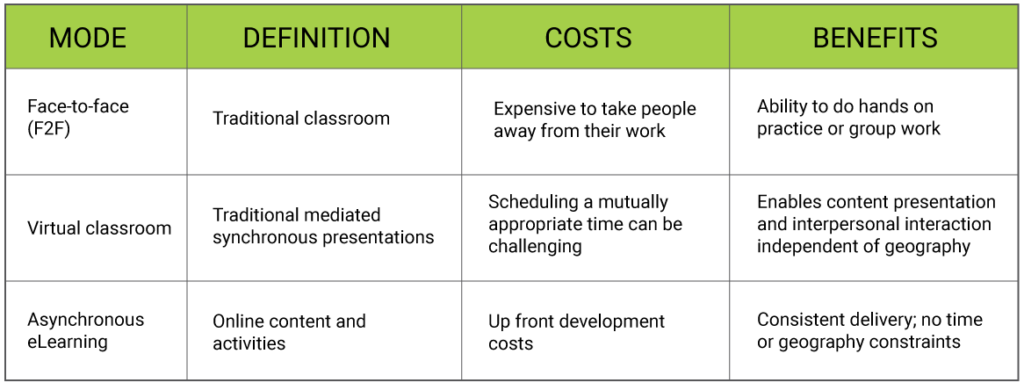Blending is Better – Guest Post by Dr Clark Quinn

When designing learning, the particular channels you can use – face to face, online, etc – have different benefits and costs. If you are forced to use one, there are a variety of ways to make the most of it. But when you move from designing a learning ‘event’ to designing a learning experience, you want to ensure that you are looking to optimize the outcome, and that includes considering multiple channels. And it is learning experiences that lead to sustained new abilities, the ones that are needed to ensure your organization not just survives, but thrives.
The event model, taking a class whether face to face or online, is problematic. Not the least problem is the issue of spacing learning. The research shows that a one pass learning experience has minimal retention; the learning dissipates quickly. If you want the learning to ‘stick’ (and if you don’t, why are you bothering?), you need to do more. It turns out that there’s only a certain amount of strengthening of associations in the brain (the process of learning) that can be done in any one day before the brain literally needs sleep to support ongoing learning. The strengthening in any one day is unlikely to lead to persistent learning. Hence the call to move from an event model to a distributed learning experience.
And, if we’re moving away from the event, we have the opportunity to use different channels for different learning components. This is what we mean by blending, to ‘blend’ together different modalities to deliver a learning experience. To optimize the potential, we need to understand what those channels offer. The most widely use alternatives are face to face, virtual classrooms, and asynchronous eLearning.
Note that the above assumes they’re used well; there are many ways in which we misuse all of these, particularly a bad learning design of information presentation and knowledge test. Real learning requires a conceptual framework to guide meaningful practice that mimics the decisions required in the workplace. For the rest of the discussion, we’ll assume an enlightened pedagogy.
The most common form of blending is to precede an in-person event with some asynchronous (traditional) eLearning, so that the expensive F2F or virtual time isn’t used for information recitation, but instead for meaningful interaction. Traditional eLearning is used to introduce and motivate the learning, present and assess the concepts, as well as to present examples. In many instances, some initial practice is also included, and some personal work that can seed the interpersonal interaction. F2F time, then, can be used to practice hands-on with equipment or simulations alone or in groups and reflect, or to engage in some group problem-solving. Virtual classrooms can also be used for group activities and discussion. In both cases, the facilitator moves from presentation to a facilitation role.
An extension is to supplement these with a follow-up eLearning session that can reactivate the learning, and/or present greater depth with scenarios or simulations that extend the learning. Companies have found significant savings from such blended models, using the eLearning to reduce the needed F2F time and yet achieving better learning outcomes.
While this model is to be lauded, there are more ways to blend learning. Less common but still prevalent alternatives include:
- Work-embedded learning: delivering learning through the work interface, not separated from the job
- Performance Support: providing job aids at the moment of need, avoiding the often-fruitless attempt to put arbitrary knowledge in the head
- Stretch assignments: giving learners tasks that require them to apply the learning from courses to their jobs in ways that are at the edge of their capability and drive or exercise their learning
- Mentoring/Coaching: providing support that develops either specific skills or more general abilities in the context of their regular work
- Social network: a place where practitioners can come to ask questions, offer advice, and share learnings
Imagine, for example, a more robust learning experience that combines a number of these:
- An initial eLearning that provides the initial concepts (whether sales, leadership, or any other workplace learning goals)
- A F2F session that helps learners meet one another and has them practice some skills in role-plays or with simulations, as well as group work around challenging problems
- A series of stretch assignments with gradually increasing complexity and relevance…
- Coupled with those stretch assignments are virtual classrooms where the learners get together and share their thinking, processes, and outcomes of the stretch assignments
- A schedule for a regular series of meetings with a mentor or coach to check in and that cease when both agree the learning’s accomplished
- A social network or community of practice where learners can develop each other together in an ongoing basis
- And a series of job aids throughout the process that provide support when performing
Such an approach is comprehensive, addresses learning that is aligned with where the learner is in a progression from novice through practitioner to the edges of expertise. The blend depends on the types of learning outcomes needed, but all should deliver a mix of concepts, practice, and reflection, individual and social.
Compare the outcomes of such a program with the outcome of an event, regardless of modality. We know that without reactivation of the learning over time, the learning will atrophy rapidly. And realize that while this may seem like a lot, if you put in place the infrastructure, doing this again and again becomes easy.
The take home: stop taking off-the-shelf one-mode event solutions, and start mixing and blending your own solutions that leverage infrastructure and optimize outcomes. Does your organization deserve any less?






